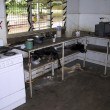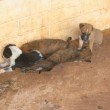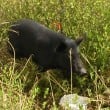B6.1 Dogs, horses, pigs and other large animals
Animals, including dogs, cats, pigs, horses, camels and donkeys can scavenge for food in and around the house, and they may contaminate the food and spread disease and litter. Animals will also drink from dripping yard taps and pools of water under the tap and in the yard. This can contaminate the water and surrounding area where children might play. Animals also deposit faeces around the living area, which can transmit worms and bacteria. Animal faeces in the surrounding environment can also be a food source for flies that can carry bacteria.
Data shows that one or more dogs were present in 62% of houses surveyed and many residents reported the regular presence of other pests (37%).
Rubbish scraps in the house can attract dogs and cats and a working rubbish bin is necessary. Larger animals scavenging in the yard area make rubbish collection systems essential. Rubbish bins were available in only 44% of houses, and only of an adequate size and well sealed in 32% of houses, an increase of 18% since 2013.
Design and Specification
Ensure
- B6.1 .1.
any yard development includes robust fences and gates
- B6.1 .2.
yard tap points are well supported
- B6.1 .3.
yard taps, evaporative cooler run off water, stormwater and hot water system discharge are well drained to prevent the pooling of water in the yard that attracts animals
- B6.1 .4.
to animal proof rubbish bins, by providing a fixing post to avoid overturning of the bin, or providing a covered secure enclosure for bins
- B6.1 .5.
to screen off the area under suspended floors to prevent access by animals, but provide a gate for maintenance access
- B6.1 .6.
external entries to the house have solid core doors
- B6.1 .7.
low windows (to ground level) are avoided and if existing houses have low windows, protect any opening windows from access by animals
- B6.1 .8.
exterior screen doors are in-filled with insect mesh that is resistant to scratching from dogs and cats
Consider
- locating food storage cupboards and shelves above 900mm, with handles located towards the bottom of the door to allow easy access
- using lockable self-closing pantry doors, for example with a tapered hinge
- providing storage for clothes and personal effects in bedrooms, bathrooms and laundries to prevent these laying on the floor and accessible to dogs, cats and other pests
- providing storage areas for food, clothes, bins that are accessible to people with disabilities by locating handles and locks 900mm to 1100mm above the floor or ground level, ensuring the paths to bin areas are at least 1 metre wide and specifying circulation around cupboards and bin enclosures to allow access
- using self-closing screen doors to stop animals entering the house
- providing screens and gates to verandahs, to keep animals out of these areas
- installing high shelves for storing food and utensils near outdoor cooking facilities
- in remote areas, protecting taps and the supply pipe with a strong ground post fixed to a concrete ground pad and/or boxing the head of the tap to prevent animals turning on the tap or chewing off the tap handle
Real world examples of Solutions
-
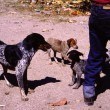 Dog health programs are important for human health
Dog health programs are important for human health -
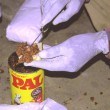 Dog health programs can include treating infections, reducing the population of dogs or the breeding capacity.
Dog health programs can include treating infections, reducing the population of dogs or the breeding capacity. -
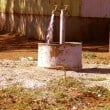 Preventing water pooling under yard taps can remove the 'drinking point' for animals and reduce animal waste around the tap point.
Preventing water pooling under yard taps can remove the 'drinking point' for animals and reduce animal waste around the tap point. -
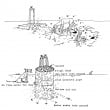 How yard area water points can become health hazards and the solution
How yard area water points can become health hazards and the solution
- B6.1 .1.
Quality control
- kitchen high level shelves are provided and are secure and the pantry door and lock are working

- DURING CONSTRUCTION
AT HANDOVER
FINAL COMPLETION
- DURING CONSTRUCTION
- screen doors, fences and gates have been installed as specified

- COMPLETED DESIGN & SPECIFICATION
AT HANDOVER
- COMPLETED DESIGN & SPECIFICATION
- under floor areas (if applicable) to houses have been screened and there is a gate for maintenance

- COMPLETED DESIGN & SPECIFICATION
AT HANDOVER
FINAL COMPLETION
- COMPLETED DESIGN & SPECIFICATION
- there is a secure storage area for garbage bins, accessible from the house by a pathway

- COMPLETED DESIGN & SPECIFICATION
AT HANDOVER
FINAL COMPLETION
TRADE TEST
- COMPLETED DESIGN & SPECIFICATION
- the yard taps are secure and working

- AT HANDOVER
FINAL COMPLETION
TRADE TEST
- AT HANDOVER
- there is a working drain, sump or pit under all yard taps and down pipes.

- COMPLETED DESIGN & SPECIFICATION
DURING CONSTRUCTION
AT HANDOVER
FINAL COMPLETION
- COMPLETED DESIGN & SPECIFICATION
- kitchen high level shelves are provided and are secure and the pantry door and lock are working
Maintenance
As part of cyclical maintenance, check that:
- high storage shelves are in good condition

- Carpenter, Local Maintenance Team
- 12 Months
- the pantry door and lock are working

- Carpenter, Local Maintenance Team
- 12 Months
- screen doors, gates and fences are in good condition

- Carpenter, Local Maintenance Team
- 12 Months
- under floor area of the house is screened and the gate is working

- Carpenter, Local Maintenance Team
- 12 Months
- the garbage bin is secured and is in good condition

- Local Maintenance Team
- 12 Months
- yard taps are secure and not dripping.

- Plumber, Local Maintenance Team
- 12 Months
- high storage shelves are in good condition
Standard And References
Harris, G & Irving, R 2000, ‘Community dogs and their health’ in G Harris (ed.), Environmental Health Handbook: A Practical Guide for Remote Communities, Menzies School of Health Research, Casuarina, pp. 59−72.
Nganampa Health Council Inc., South Australian Health Commission and Aboriginal Health Organisation of South Australia 1987, Report of Uwankara Palyanyku Kanyintjaku, An Environmental and Public Health Review within the Anangu Pitjantjatjara Lands, Alice Springs, p. 21.
Pholeros, P 1991, AP Design Guide, Building for Health on the Anangu Pitjantjatjara Lands, Nganampa Health Council Inc., Alice Springs, p. 45.

